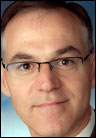Sep 20, 2011Three years after developing a real-time location system (RTLS) solution to improve patient care at the University of Pittsburg Medical Center (UPMC), the company that spun out of that effort—SmartRoom—is currently installing a similar solution at Stamford Hospital, in Connecticut, using the same ultrasound ID badges and receivers, along with its own software, provided and installed by IBM. The firm plans to expand UPMC's system with Wi-Fi-based RTLS tags in 2012.
The Stamford Hospital system will utilize Sonitor Technologies' RTLS to identify which staff members enter a particular patient's room, displaying that employee's name and title on a monitor for the patient, while also providing data about that patient—such as his or her vital signs and care requirements—on the same screen. In that way, workers have real-time accurate information regarding a patient upon entering that person's room. The system can provide different data to a particular individual, based on his or her function at the hospital; for example, the housekeeping staff might need to view details regarding a patient's personal belongings (such as eyeglasses or dentures), in order to take care not to discard them.
The technology, using Sonitor's ultrasound solution, was first installed at one of UPMC's facilities in Pittsburgh to protect against errors, according to David Sharbaugh, SmartRoom's founder and president, and UPMC's former senior director of quality and innovation. The hospital wanted to ensure that no medication or health-care product would be utilized with any patients who might have allergies to that product, for example. Typically, physicians scan paperwork or PC screens to review that data upon entering a patient's room, but errors can be made when the pertinent information is simply overlooked.
Sharbaugh says that while working for UPMC, he was tasked with determining how to provide computer data to staff members most efficiently. The solution was something he himself developed approximately four years ago, consisting of Sonitor's tags that transmit unique ultrasound signals to the company's receivers, along with a software platform designed by Sharbaugh and dubbed SmartRoom. Employees began wearing Sonitor ultrasound tags that transmit an acoustic signal inaudible to the human ear, every five seconds, with each transmission unique to that tag, so that the SmartRoom system could identify each one specifically. Sonitor receivers were installed within hallways and patient rooms that received the transmissions, linking every specific transmission with an individual, and then forwarding that information, along with the receiver's own unique identifier, to the SmartRoom software residing on UPMC's database, via a cabled connection.
The software first displays data on the patient room's touch screen, listing the caregiver's name and job title, to be viewed by the patient. It also determines the type of data that caregiver requires from the patient's electronic records, and displays that information on the same screen for the caregiver. The data could include not only allergies, but also dietary restrictions, vital signs, medical test results and medications due to be administered.
Based on the system's success, Sharbaugh founded SmartRoom to provide the solution to other hospitals, and the company was launched in July 2010. The firm can work with several solutions providers and various RTLS technologies, including those providing active RFID tags (those using Wi-Fi technology, for instance) and tags that employ infrared or ultrasound technology, as well as several combinations of the technologies. To date, he says, the company has partnered with Sonitor, as well as RTLS providers CenTrak and AeroScout. "We're agnostic," he states. "We can work with any RTLS vendor." The solution is being marketed and installed by IBM, which also serves as the project's systems integrator.
Once completed, in the first quarter of 2012, the Stamford solution will include approximately 1,000 asset tags and 1,000 staff badges, Sharbaugh says, with about 275 receivers installed in as many rooms and hallways. The hospital has declined to comment about the system until after its installation is complete.
At present, UPMC is planning an expansion of its own hospital, with a new 150-bed unit slated to open in July 2012. At this location, the facility will use AeroScout's Wi-Fi-based RTLS hardware and MobileView software to link data to SmartRoom software on UPMC's back-end system. The hospital selected the AeroScout solution, which will be installed by UPMC and AeroScout.
A somewhat similar solution was developed by Patient Care Technology Systems—prior to its acquisition by Awarepoint in April 2011 (see RFID News Roundup: Awarepoint Acquires PCTS)—known as Smart Boards (see MultiCare Health's Good Samaritan Hospital to Install Smart Boards).


